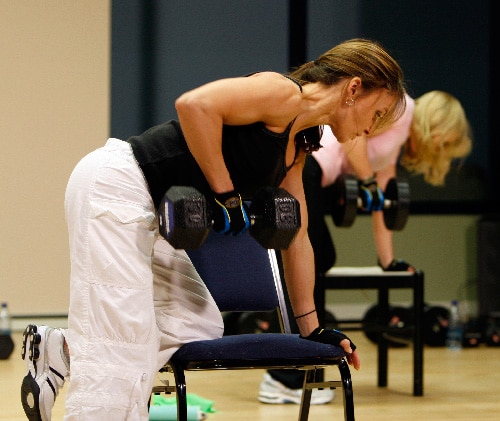
Muscles age just like the rest of your body. You begin to lose muscle mass after the age of 30. This loss is slow during early middle age but speeds up around age 50. Resistance training slows down the rate of muscle loss and helps to preserve lean body mass. That’s important since loss of muscle tissue is a major factor that contributes to falls and loss of functional capactiy later in life.
No doubt strength training is important but what’s less well appreciated is the importance of power training. Resistance training improves muscle strength and mass. yet this is only one element that affects functional capacity. Research suggests it’s not just loss of strength and muscle mass that makes it harder for older adults to do the things they once enjoyed, it’s loss of strength AND power. Power training is an element of fitness training that isn’t always emphasized enough.
Research shows strength and power both decrease with age. This process accelerates after the age of 60. Beginning at age 60, adults lose power at a rate of around 3.5% per year. In fact, loss of power occurs at a faster rate than loss of strength as weage.
What is Power and How Does It Differ from Strength?
Muscle strength is measured by how much weight a person can lift one time. You one-rep max, the amount of weight you can lift for one repetition is a rough measure of strength. Strength considers only the maximum amount of force a muscle can generate. It doesn’t take into account how quickly you can lift a force can be lifted. In contrast, power adds the element of speed. The definition of power is velocity or speed multiplied by force. You can measure power using various fitness tests including the standard long jump test or the vertical jump test.
The Ability to Generate Power Decreases with Age
You lose strength and muscles mass with age but muscle power declines significantly after the age of 50. Research shows men and women lose a greater proportion of fast-twitch muscle fibers with age due to a decrease in fiber number and fiber size Fast-twitch fibers are those involved in power moves. Slow-twitch muscle fibers, ones best suited for endurance exercise, are better preserved during aging.
Why is this important? Research shows it’s the ability to generate power that helps people carry out the activities they do on a daily basis like climbing stairs and rising from a chair. Studies show lower body power is a strong predictor of functional status in older women. Women that lack power in their legs and lower body are more likely to fall. In fact, one study showed women that fell had 24% less power in their lower extremities than women who didn’t fall.
The emphasis has always been on preserving strength and muscle mass but power training is no less important, especially as we age. Gains in strength through low-velocity resistance training don’t necessarily translate into improved functional capacity, the ability to carry out daily activities. Preservation of power seems to be most important for preserving function.
Of course, strength training is still vital but power exercises are too. Some research shows power training may be more effective for improving the functional abilities of older people than low-velocity strength training.
Power training is also important if you play sports. Think about the number of times you have to generate force quickly when you play sports like volleyball and you’ll understand how power training can make you a better athlete.
The Importance of Adding Power Training to Your Workout
Strength-training is important for preserving muscle mass with age but power training helps maintain function. When you strength train, you use a weight that’s between 70 and 100% of your one-rep max with the goal of lifting to near failure. If you’re lifting 70% of your one rep max it may take 12 reps to reach failure whereas you might only need to lift a weight that’s 90% of your one-rep max four or five times . Speed isn’t an issue with strength training. Your goal is do a high enough number of reps to thoroughly fatigue the muscle.
With power training, the focus is on speed, moving the weight as quickly as possible. To develop power, you would use a moderate weight, 70 to 80% range and a moderate number of reps. You don’t have to use weights to do power training. Plyometric moves like squat jumps, vertical jumps and tuck jumps also build power as well as muscle endurance. What about kettlebells? Kettlebell workouts are ideal for building power due to their focus on whole body explosive moves.
Before adding power training to your workout, work on strength first. Your muscles need conditioning before doing high-velocity moves that build power. Once you’ve developed some strength, gradually add power training moves to your routine. To reduce the risk of injury and overtraining, periodize your training. Work on strength during one cycle followed by muscle endurance in the next cycle and then power training. This will give you a balanced conditioning workout.
The Bottom Line?
Strength-training helps preserve strength and muscle mass but power training may be the key to maintaining a high level of function as you age. Add some power moves to your workouts. They’ll improve your overall athletic performance, add variety and keep your muscles functioning at their highest level.
References:
Int. J. Exerc. Sci 2(2): 131-151, 2009.
Curr Aging Sci. 2008 Mar;1(1):62-7.
IDEA Health and Fitness Association. “Power Training For Older Adults”
J Aging Phys Act. 2007 Jul;15(3):336-48.
Exp Gerontol. 2013 May;48(5):492-8.
Int J Exerc Sci 2(2): 131-151, 2009.
Related Articles By Cathe:
Strength Versus Power: What’s the Difference and Which Is More Important for Sports Performance?

